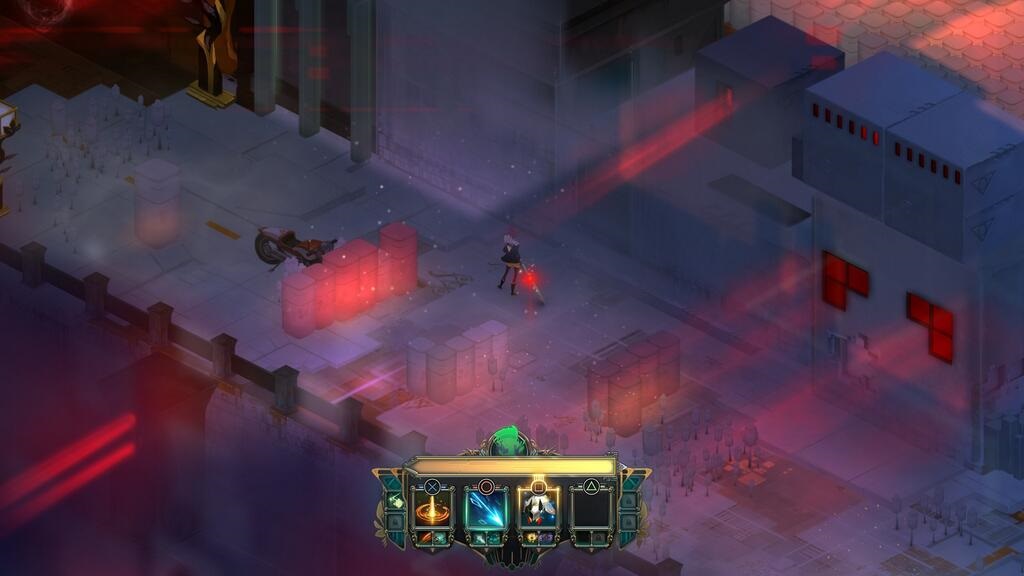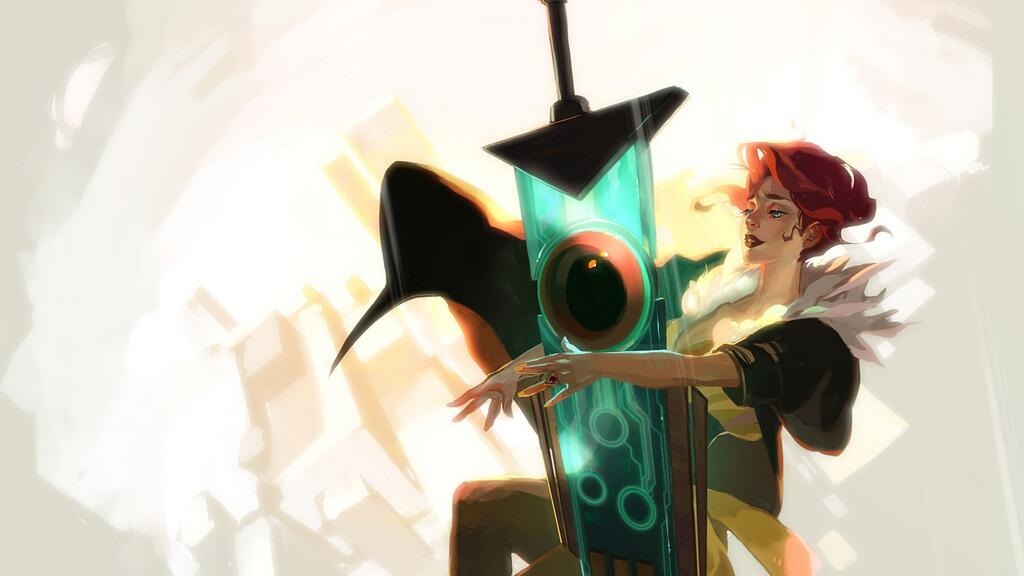As each person adventures alone in Bastion, piecing together the world with each step, a narrator watches. The narrator stays an observer, never guiding players down a path. Transistor doesn’t accompany players with a narrator, but with a voice imbedded inside a sword called the Transistor. The sword’s voice fills the empty air left from the voiceless main character, Red. Despite any resistance from the Transistor, Red pushes forward to unravel pieces of story neither Red nor the player can begin to form. When players learn of the the enemies called the Process, players simultaneously unravel an ambiguous, forced story wrapped around an ingenious turn-based combat system.
Red, a popular singer in Cloudbank, wakes up in a plaza without her most valuable tool, her voice. She soon finds a sword embedded in a man’s chest who now finds himself implanted into the sword. Too large to carry, Red drags the sword along looking for her voice and discovering why all citizens abandoned Cloudbank.
To safely wander the different districts of Cloudbank, Red uses the Transistor to plan her attacks within a turn-based combat system. Actions and a movement consume the action meter, encouraging players to maximize damage output from a single turn. Players can use abilities outside of the turn-based freeze time, but the damage intake from real-time combat makes death a likely risk. Players want to avoid death to keep access to all Functions. Once Red’s health meter empties she revives with a fresh health bar but one less Function to use.

Access to all Functions means players can properly execute their plans. Each Function can operate as a passive buff, an active ability or an upgrade to an existing ability. The Bounce Function for example, when used as an active, shoots a bolt that bounces off enemies. As a passive, Bounce creates a damage absorbing shield, and as an upgrade Bounce gives chain-reactive attributes to other abilities.
The four Function slots and two upgrade slots mean players can create hundreds of different combinations. At each opportunity to customize Functions, I uninstalled everything and started from scratch to see what new combinations I could think of. Functions each require different amounts of REM points to prevent players from just installing everything into empty slots. With a limited pool of REM points I opted to fully upgrade two or three abilities instead of four half upgraded Functions. The number of upgrades, passives and Functions all depends on player preference.
Players should adapt Red’s Functions to active difficulty modifiers called Limiters. Upon death enemies drop Cells which when collected prevents enemy respawns. Limiters can change things like Cell properties to increase difficulty, but Limiters reward players with bonus experience points. One Limiter shields Cells which needs to be removed before collecting the Cells. My Function set couldn’t deal with shielded Cells – my function set focused on backstab damage and commanding cybernetic dogs to kill distance enemies. Area-of-effect Functions best eliminate shielded Cells, so catering the limiters to my Function set increased the game difficulty without any unfair changes.

I want to explore and kill enemies in the fewest turns possible, so the Backdoor, the trials and challenges mode in Transistor didn’t quite feel the same because of the predetermined Functions. I want to explore the mysterious, slightly futuristic Cloudbank and see my functions in action, but the story’s insistence to shift attention to surrounding issues and the relationship between Red and the sword meant gameplay only felt like a bridge between plot points. Transistor wants me to care about Cloudbank and whoever got stuck in the Transistor, yet I only cared for Red, not Cloudbank citizens or the randomly introduced antagonists behind the spread of the Process.
Throughout Cloudbank players can interact with OVC Terminals to read news headlines, vote on weather conditions or even order take-out food. Players find dozens of these terminals in Cloudbank, so much so I thought each selection would alter the story in some way. They don’t. Aside from injecting a little flavour and culture into the crafted world, OVC Terminals emit an aura of significance that loosely impacts the story.
The separation between the terminals, gameplay and plot ultimately reveals the unevenness of Transistor and the failure to create a coherent game experience. When the credits roll and the story ends, Transistor still doesn’t feel complete. All the different parts of Transistor seem to belong to different games and run parallel to each rather than working in conjunction. Some players might appreciate the plot and exploring Cloudbank rather than managing abilities in a menu screen, but I came away remembering my backstabbing Function set, nothing else.

